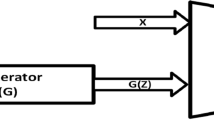Abstract
Flow-based generative models (flow models) are conceptually attractive due to tractability of the exact log-likelihood and the exact latent-variable inference. In order to generate sharper images and extend the Gaussian prior of Flow models to other discrete forms, we propose an adversarial non-volume preserving flow model with Boltzmann priors (ANVP) for modeling complex high-dimensional densities. In order to generate sharper images, an ANVP model introduces an adversarial regularizer into the loss function to penalize the condition that it places a high probability in regions where the training data distribution has a low density. Moreover, we show that the Gaussian prior can be extended to other forms such as the Boltzmann prior in the proposed ANVP model, and we use multi-scale transformations and Boltzmann priors to model the data distribution. The experiments show that proposed model is effective in image generation task.








Similar content being viewed by others
Explore related subjects
Discover the latest articles, news and stories from top researchers in related subjects.References
Dinh L, Krueger D, Bengio Y (2015) NICE: Non-linear independent components estimation. In: International conference on learning representations
Kingma D, Welling M (2013) Auto-encoding variational bayes. In: International conference on learning representations
Goodfellow I, Pouget-Abadie J, Mirza M et al (2014) Generative adversarial nets. In: International conference on neural information processing systems
Gulrajani I, Ahmed F, Arjovsky M et al (2017) Improved training of wasserstein GANs. In: International conference on neural information processing systems
Metz L, Poole B, Pfau D et al (2017) Unrolled generative adversarial networks. In: International conference on learning representations
Nair V, Hinton G (2010) Rectified linear units improve restricted boltzmann machines. In: International conference on machine learning
Dinh L, Sohl-Dickstein J, Bengio S (2017) Density estimation using Real NVP. In: International conference on learning representations
Kingma D, Dhariwal P (2018) Glow: generative flow with invertible 1 × 1 convolutions. In: International conference on neural information processing systems
Zhang N (2019) Point-wise gated restricted Boltzmann machines using clean data. Int J Collab Intell 2(1):75–82
Grégoire M, Klaus-Robert M, Marco C (2016) Wasserstein training of restricted Boltzmann machines. In: International conference on neural information processing systems
Fisher C, Smith A, Walsh J (2018) Boltzmann encoded adversarial machines. arXiv 1804.086822018
Zhang N, Ding S, Zhang J et al (2017) An overview on restricted Boltzmann machines. Neurocomputing 275:1186–1199
Hinton G (2012) A practical guide to training restricted Boltzmann machines, neural networks: tricks of the trade. Springer, Berlin Heidelberg, pp 599–619
Mescheder L, Nowozin S, Geiger A (2017) Adversarial variational bayes: unifying variational autoencoders and generative adversarial networks. In: International conference on neural information processing systems
Du M, Ding S, Xu X et al (2018) Density peaks clustering using geodesic distances. Int J Mach Learn Cybernet 9(8):1335–1349
Li M (2019) NNGDPC: a kNNG-based density peaks clustering. Int J Collab Intell 2(1):1–15
He K, Zhang X, Ren S et al (2016) Deep Residual learning for image recognition. In: IEEE conference on computer vision and pattern recognition
Acknowledgements
This work is supported by Outstanding Innovation Scholarship for Doctoral Candidate of CUMT. No. 2019YCBS058.
Author information
Authors and Affiliations
Corresponding author
Additional information
Publisher's Note
Springer Nature remains neutral with regard to jurisdictional claims in published maps and institutional affiliations.
Rights and permissions
About this article
Cite this article
Zhang, J., Ding, S. & Jia, W. An adversarial non-volume preserving flow model with Boltzmann priors. Int. J. Mach. Learn. & Cyber. 11, 913–921 (2020). https://doi.org/10.1007/s13042-019-01048-8
Received:
Accepted:
Published:
Issue Date:
DOI: https://doi.org/10.1007/s13042-019-01048-8




